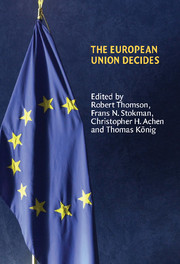Book contents
- Frontmatter
- Contents
- List of figures
- List of tables
- Notes on contributors
- Preface
- 1 Explaining legislative decision-making in the European Union
- 2 Research design: measuring actors' positions, saliences and capabilities
- 3 Testing procedural models of EU legislative decision-making
- 4 Institutional realism and bargaining models
- 5 Compromise, exchange and challenge in the European Union
- 6 Nash versus Schelling? The importance of constraints in legislative bargaining
- 7 A cooperative approach to decision-making in the European Union
- 8 A procedural exchange model of EU legislative politics
- 9 Beyond informal compromise: testing conditional formal procedures of EU decision-making
- 10 Evaluating political decision-making models
- 11 Evidence with insight: what models contribute to EU research
- Appendix I Selection of Commission proposals
- Appendix II Comparison of expert judgements with each other and with information from Council documentation
- References
- Index
- Title in this series
2 - Research design: measuring actors' positions, saliences and capabilities
Published online by Cambridge University Press: 22 September 2009
- Frontmatter
- Contents
- List of figures
- List of tables
- Notes on contributors
- Preface
- 1 Explaining legislative decision-making in the European Union
- 2 Research design: measuring actors' positions, saliences and capabilities
- 3 Testing procedural models of EU legislative decision-making
- 4 Institutional realism and bargaining models
- 5 Compromise, exchange and challenge in the European Union
- 6 Nash versus Schelling? The importance of constraints in legislative bargaining
- 7 A cooperative approach to decision-making in the European Union
- 8 A procedural exchange model of EU legislative politics
- 9 Beyond informal compromise: testing conditional formal procedures of EU decision-making
- 10 Evaluating political decision-making models
- 11 Evidence with insight: what models contribute to EU research
- Appendix I Selection of Commission proposals
- Appendix II Comparison of expert judgements with each other and with information from Council documentation
- References
- Index
- Title in this series
Summary
The aim of this study is to apply and compare different explanations of legislative decision-making in the European Union (EU). Two features of the research design are particularly important with respect to achieving this aim. First, the selection of cases must cover a sufficient number and variety of cases to count as a test of the explanations. Second, a way of thinking about very different decision situations has to be devised, such that they can be compared, in terms of the applicability of different explanations in any given situation, and in terms of the performance of explanations in different situations. Stating explanations in the form of models is part of the endeavour to facilitate comparison. Another part is the conceptualisation of decision situations spatially. Political controversies are conceptualised as issue continua or scales, with actors placed at different positions on these issues. The Commission proposal on tobacco products will be used to illustrate the data collection process. One of the issues raised by this proposal was the size of the health warning on tobacco products: see the second issue described in Figure 2.1. At one end of this issue continuum, we find the status quo position at that time, consisting of relatively small warnings. At the other end of the continuum, we find the alternative of very large health warnings using very strong language. Intermediate alternatives are placed on positions between these two alternatives. This way of defining issues is essential to the comparison of different explanatory models' performance.
- Type
- Chapter
- Information
- The European Union Decides , pp. 25 - 53Publisher: Cambridge University PressPrint publication year: 2006
- 43
- Cited by

